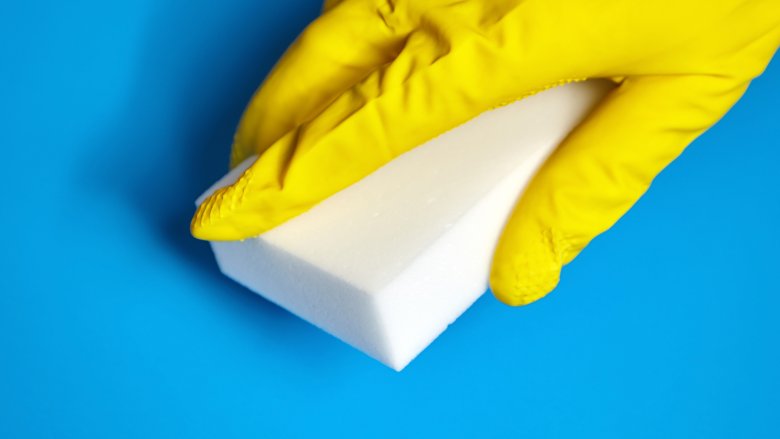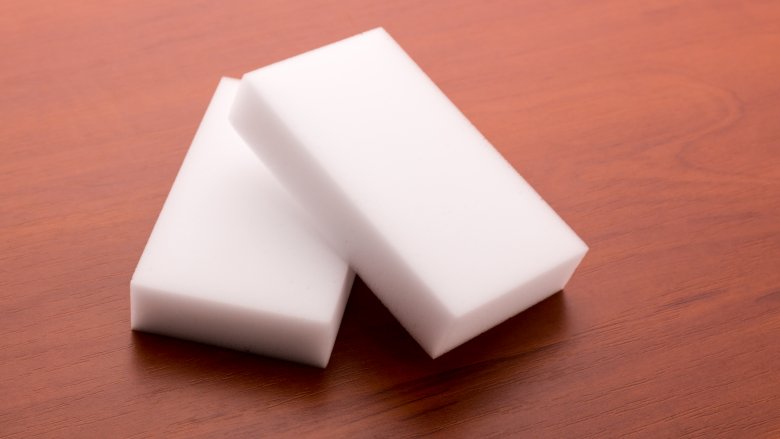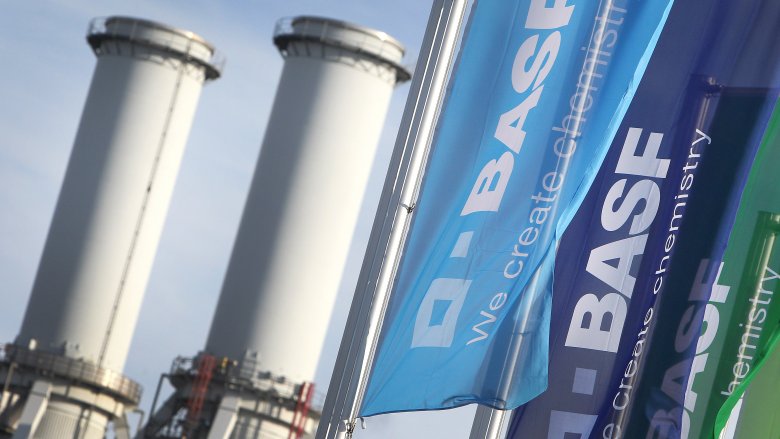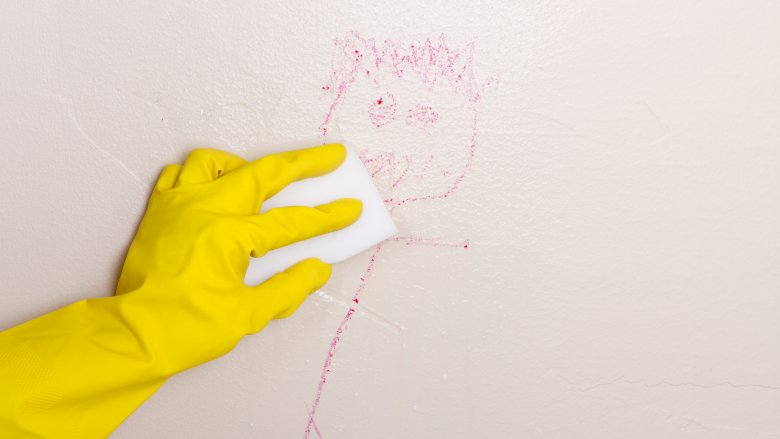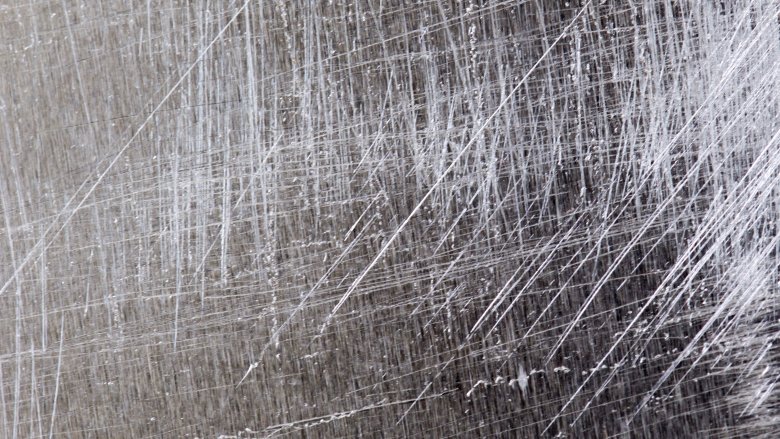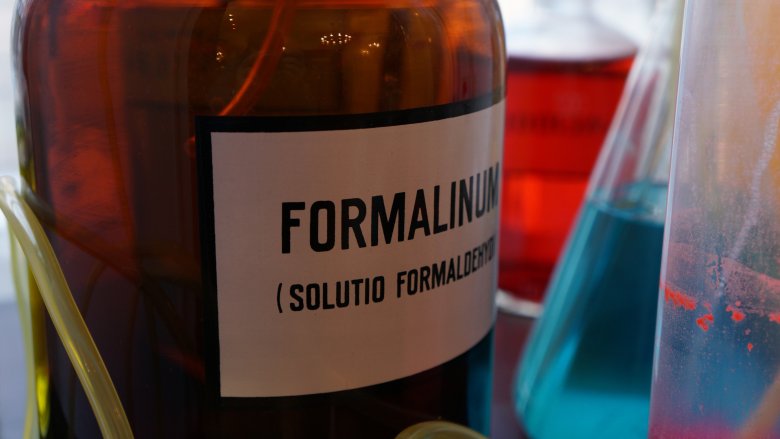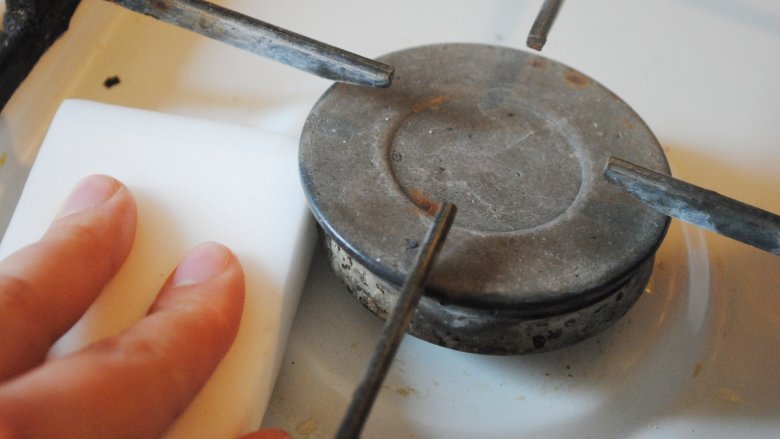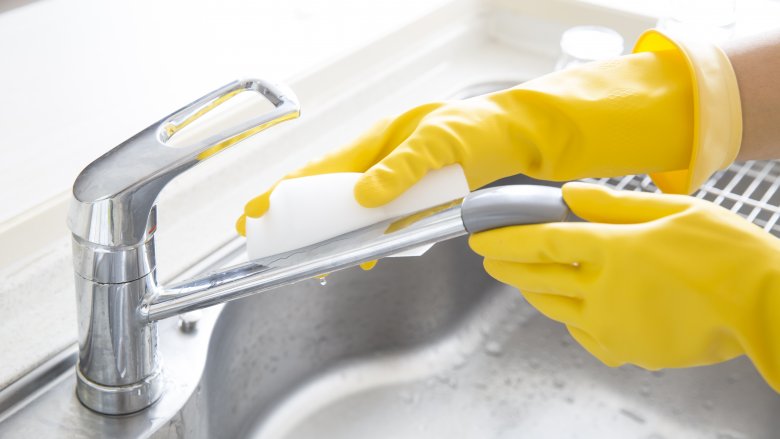The Untold Truth Of Magic Eraser
Our world is full of remarkable innovations. There's the Large Hadron Collider. The International Space Station. And, of course, the Magic Eraser.
As any parent can tell you, life without Magic Erasers would be like living in the first circle of hell, if hell were a bunch of white walls covered with crayon scribbles. The Magic Eraser has changed the way anyone with a child reacts to the sight of Sharpie-covered dinnerware or a favorite toy smeared with some indeterminate substance. In the before time, things blemished in such a way would go straight into the garbage because there would be no way to save them. Then in 2003 some freaking genius whose name no one seems to recall invented the Magic Eraser, and today parents fear the Sharpie no more. Really, as a technological innovation not even the Large Hadron Collider or the International Space Station can compete. Here's the story behind the Magic Eraser.
So what exactly is the divine substance those little white rectangles of joy are made from?
Magic Erasers are clearly some kind of sponge, but what the heck? They are bright white, super light and airy, and they disintegrate long before you're really willing to part with them. That's because they aren't sponges at all; they're a kind of foam and one of their base ingredients is melamine, which is the same stuff in that weird, not-microwave-safe set of plates your mother in law bought you at Target.
Magic Erasers are not really very similar to their dinnerware cousins, though, because they undergo a chemical process that turns them into something called "melamine foam." And although it's true that most people never saw a piece of melamine foam until the day Procter & Gamble blessed the world with the Magic Eraser, the stuff is not actually new. According to How Stuff Works, it's been around for a couple decades and is still used today as sound and temperature insulation. So besides cleaning those crayon marks off your walls, you could also stuff Magic Erasers into your drafty window sills or maybe line your garage walls with it after your mother-in-law also buys your teenage son a drum kit.
A miracle is born
History does not remember the ah-ha moment when that one nameless genius first tried to clean a scuff mark with a piece of melamine foam. That's a pretty significant moment to just up and forget, but you can't catch 'em all. According to BASF, the chemical company that produces melamine foam for the Magic Eraser, the discovery came about through "persistence and a little bit of luck — and researchers across geographies and divisions regularly communicating and collaborating." Which is super boring, BASF. You totally need to find someone else to write the innovation page on your website because everyone just fell asleep.
Anyway, BASF also implies that someone was basically just looking at new ways to use existing products, and one of the things they tried was using insulation to clean crayon. The book Throwing Rocks at the Google Bus: How Growth Became the Enemy of Prosperity says the discovery was actually made by Procter & Gamble, who partnered with BASF to package the stuff as the Mr. Clean Magic Eraser, complete with smiling bald buff dude cartoon spokesperson. And all was right with the world.
Good news: Mr. Clean doesn't have exclusive rights to melamine foam
Okay, so the only real problem with the world's most remarkable invention is the cost. Magic Erasers cost about $1 each, which doesn't sound terrible until you use one and realize that its total productive lifespan is about 10 minutes. Magic Erasers tend to disintegrate as they're being applied to those stubborn stains, so when you're done you have a spot-free wall and a pile of melamine crumbs on the carpet. So really, that dollar doesn't go very far, especially if your little Picasso covered the whole dang wall from carpet to armpit.
What Procter & Gamble and BASF probably don't want you to know is that you don't have to buy melamine foam that says "Magic Eraser" on the package to obtain a product with the cleaning power of a mighty bald buff dude and the staying power of your freshman college sweetheart. According to CNet, you can buy generic melamine foam squares in bulk for around 8 cents each. The bulk squares tend to be a little smaller than the ones packaged under the Mr. Clean brand, but the effectiveness will be pretty much the same. The real difference is you won't have to work extra hours on the night shift to pay for the 25 packs of Magic Erasers you had to buy to counter your child's latest beautiful gallery of self-expression.
You're not cleaning, you're exfoliating
So just how does this miracle of miracles perform its miraculous task? Is it blessed with magical unicorn dust? Or is it something more sinister, like maybe Mr. Clean got his rugged good looks and supernatural cleaning power when he made a deal with the Dirt Devil? That would certainly explain a lot, but no. Despite its name, there is no real magic behind the Magic Eraser. According to How Stuff Works, the Magic Eraser is abrasive, kind of like very, very fine-grit sandpaper, or Russell Crowe. So when you're cleaning the stains off your wall or that family heirloom, keep in mind that you aren't actually dissolving the stain the way some other cleaning products might — you're exfoliating it. Which means your eraser is not really discriminating between the stain and the surface the stain is sitting on.
That's okay for your walls, which could conceivably be touched up with a coat of paint after you've gone all Magic Eraser-happy on them, but it's maybe not so great for Grandma's polished mahogany chickens. For those, maybe consult an antique restoration pro instead or, you know, just throw them in the trash. We won't tell.
Eek, formaldehyde
Do you remember how people said your dog would die if you tried to get rid of the doggy stink on his bed with a few squirts of Febreeze, or how your cat would also die if you cleaned your floors with a Swiffer? People do love to start rumors about cleaning products, and the Magic Eraser has not escaped the scrutiny of the "all chemicals are evil" crowd.
Back in 2006, someone started an email-based rumor that Magic Erasers contain formaldehyde. You know, "the chemical they use to preserve dead people." So the implication was that when you use a Magic Eraser you're basically leaving embalming fluids all over your walls and furniture, and no one wants that. Unsurprisingly, it was Snopes who busted the rumor — they reprinted Procter & Gamble's rebuttal not long after the email made its appearance. Don't worry, the rebuttal said, the misunderstanding comes from the presence of the word "formaldehyde" in the product's chemical name, which is melamine-formaldehyde-sodium bisulfite copolymer, or, in layman's terms, the Sponge of Satan.
In their statement, the company promised there was no actual formaldehyde in the product, though they did say the manufacturing process might leave trace amounts, but don't worry because those trace amounts were generally less than what can be found in air. Still, not everyone was comforted because Evil Corporation, and today you will still find people who are passionately committed to making sure that no parent anywhere, ever, will ever have clean walls again.
Frankenstein's favorite cleaning tool
Rest assured, there are no embalming chemicals in that wondrous rectangle of happiness, but don't rest for too long because there's still plenty of weirdness back at the lab. In fact, the process of making a Magic Eraser is a little bit like bringing Frankenstein's monster to life. You know, because of the embalming fluid.
Wired elaborates on Procter & Gamble's admittedly cagey "there's no formaldehyde except for that trace amount of formaldehyde" statement by describing the manufacturing process: To make melamine resin (which later becomes melamine foam), manufacturers mix melamine with (wait for it) formaldehyde. But the process actually neutralizes the toxic effects of the formaldehyde, so consumers don't have to worry about poisoning the dog or embalming the dining room table.
So we know what formaldehyde is, but what is melamine exactly? Well, just in case it took you a while to get over the whole formaldehyde thing, you might want to sit down for this one — according to Encyclopedia Britannica, melamine is "a crystalline solid derived from urea." And what is urea? It's "the chief nitrogenous end product of the metabolic breakdown of proteins in all mammals and some fishes ... [which] occurs not only in the urine of all mammals but also in their blood, bile, milk, and perspiration." Don't worry, though, the urea used to make melamine doesn't come from pee and sweat — it's synthesized from inorganic materials. Still, gross. And you guys were worried about the formaldehyde.
That soft foam sponge is actually as hard as glass
There's quite a huge difference between a melamine plate or countertop and that little foam square you can buy in any supermarket or hardware store, so how exactly does it get from hard, unbreakable resin to soft, dissolvable sponge? Well, it's a little bit like turning heavy cream into whipped cream — according to BASF, the melamine resin is "whipped into a foam," and the result is "an airy, open-cell construction." The company says that when dry, the cured resin is almost as hard as glass, which is what makes it so effective at getting stains off surfaces. And also surfaces off surfaces.
There's some disagreement over whether Magic Erasers need water to work properly — Procter & Gamble uses the phrase "water-activated microscrubbers," but that's not entirely accurate. Wired says there really isn't much difference between the cleaning power of a wet Magic Eraser and a dry one, although the water does help bind the dirt to the eraser, so you're actually removing it instead of just spreading it around.
Sometimes it cleans a little too well
When you first realized that Sharpie scribbles did not mark the end of your furniture's usable life, you might have gone a little nuts with the Magic Eraser. And you might have some regrets. Magic Eraser is great at removing stains but that's because it's great at removing the top couple layers of pretty much everything, particularly if it's glossy, shiny, or something passed down through the generations. So just because it's stained doesn't necessarily mean Magic Eraser is the answer.
In particular, the Family Handyman says you should avoid using Magic Erasers on marble and granite countertops and stainless steel because the abrasive eraser might dull the finish. And nonstick cookware is off-limits, too, because a Magic Eraser will take the nonstick coating right off the pan — though that does beg the question, if it's nonstick why do you need to use a Magic Eraser to remove the stuff that's stuck to it?
Magic Erasers will also strip away the finish on wood surfaces and glossy paint, and definitely don't think about using one on the outside of your car. Finally, don't use Magic Erasers on your collectibles, no matter what they're made of. You can't really predict what will happen if you use an abrasive cleaner on something old, and it's not really worth the gamble even if it might mean saving that item from the scourges of Sharpie.
Don't worry, it's ... gluten-free?
In the early days, the media was full of praise for this wonder of modern crayon removal. Time named the Magic Eraser one of the "best inventions of 2004," though they did also caution against overusing it on certain surfaces, so it's not like the Magic Eraser ever really had a reputation as a do-anything cleaning product.
But new products — especially the ones that seem kind of miraculous — are often met with suspicion, and early on there were people who claimed to have negative physical reactions to the product. There also seems to have been at least one dodo worried that Magic Erasers might not be gluten-free. Though we're really, really confused as to why that matters. Evidently, though, Magic Erasers don't contain any gluten or dairy, so that's a relief. We also have it on very good authority that Magic Erasers are not edible, and "when swallowed ... may block the gastrointestinal tract."
So don't eat them. But do know they're gluten free. We're still so confused.
Use them to clean your kids' mess, but don't use them to clean your messy kids
Magic Erasers may be very effective at removing Sharpie from a wall or a coffee cup, but from there you should absolutely not make the leap that a Magic Eraser would be a great tool for removing Sharpie from your child's face.
At least one daycare center employee evidently thought it would be worth a try, though, and now everyone is full of regret. According to Business Insider, parents filed a lawsuit against the daycare center after viewing a surveillance video in which one of the teachers was seen "handling the boys roughly while using a Magic Eraser to remove the marker."
Magic Eraser is abrasive, so it's not meant to be used on the skin — but the parents were evidently told by a pediatrician that the marks on their kids were "chemical burns," although in an earlier article ThoughtCo. noted that Magic Erasers "contain no soaps, solvents, or other chemical ingredients." That article goes on to say that the pH factor of a Magic Eraser is roughly the same as baking soda, so it seems more likely that the "burns" were actually abrasions.
Still, the story dropped out of the news cycle in July 2018, so we might never really know. One thing we do know is that Magic Erasers aren't meant to clean skin. So just don't.
